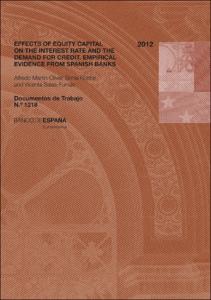Effects of equity capital on the interest rate and the demand for credit : empirical evidence from Spanish banks
Autor
Fecha de publicación
27-abr-2012
Descripción física
34 p.
Resumen
We examine the consequences of imposing higher capital requirements on banks (as under Basel III or, recently, in the case of large banks in the European context) for bank dynamics in complying with the new standards and for the long-term effects on bank lending rates and the demand for bank credit. The analysis combines econometric estimations of the determinants of equity capital ratios and lending rates with simulations of market equilibrium results for loan interest rates and the demand for bank credit, based on a parameterised model of the Spanish banking industry. We find that the gap between the target and the actual capital ratio is reduced by around 40% every year, mainly with retained earnings. We also find that raising the equity capital ratio by one percentage point increases bank lending rates by 4.2 basis points. Finally, the simulation exercise shows that the estimated increase in the cost of funds for banks associated with a one percentage point increase in the equity capital ratio leads to a fall of 0.8% in the total demand for bank credit. These results suggest that the social costs of higher equity capital requirements for banks are expected to be greater in the transition period, when banks are adjusting to the new standards, than in the steady state of the new industry equilibrium, when all banks comply with the new ratio
Este trabajo analiza las consecuencias de un aumento de los requerimientos de capital a los bancos (tal como en Basilea III o en la nueva normativa europea dirigida a los grandes bancos) tanto en el corto plazo, esto es, en la dinámica del ajuste de los bancos para cumplir con los nuevos estándares, como en el largo plazo. El análisis combina las estimaciones econométricas basadas en modelos sobre los determinantes de los ratios de capital y de los tipos de interés del crédito bancario con mediciones del impacto en el equilibrio a largo plazo en los tipos de interés y en la demanda de crédito bancario, obtenidas a partir de simulaciones basadas en las estimaciones de un modelo paramétrico para el sector bancario español. Los resultados indican que la brecha entre los ratios de capital actuales respecto a los nuevos requerimientos se cerrará con un reducción progresiva del 40% anual, principalmente mediante la retención de beneficios. Adicionalmente, el trabajo permite concluir que un aumento de un punto porcentual del ratio de capital se traduce en un aumento de 4.2 puntos básicos en los tipos de interés de los préstamos bancarios
Este trabajo analiza las consecuencias de un aumento de los requerimientos de capital a los bancos (tal como en Basilea III o en la nueva normativa europea dirigida a los grandes bancos) tanto en el corto plazo, esto es, en la dinámica del ajuste de los bancos para cumplir con los nuevos estándares, como en el largo plazo. El análisis combina las estimaciones econométricas basadas en modelos sobre los determinantes de los ratios de capital y de los tipos de interés del crédito bancario con mediciones del impacto en el equilibrio a largo plazo en los tipos de interés y en la demanda de crédito bancario, obtenidas a partir de simulaciones basadas en las estimaciones de un modelo paramétrico para el sector bancario español. Los resultados indican que la brecha entre los ratios de capital actuales respecto a los nuevos requerimientos se cerrará con un reducción progresiva del 40% anual, principalmente mediante la retención de beneficios. Adicionalmente, el trabajo permite concluir que un aumento de un punto porcentual del ratio de capital se traduce en un aumento de 4.2 puntos básicos en los tipos de interés de los préstamos bancarios
Publicado en
Documentos de Trabajo / Banco de España, 1218
Materias
Bank capital regulation; Basel III; Bank lending rates; Demand for credit; Regulación del capital bancario; Basilea III; Tipos de interés del crédito; Demanda de crédito; Riesgos y liquidez; Créditos; Regulación y supervisión de instituciones financieras; España
Aparece en las colecciones:












